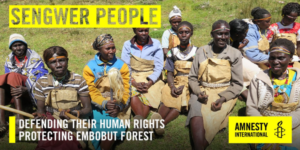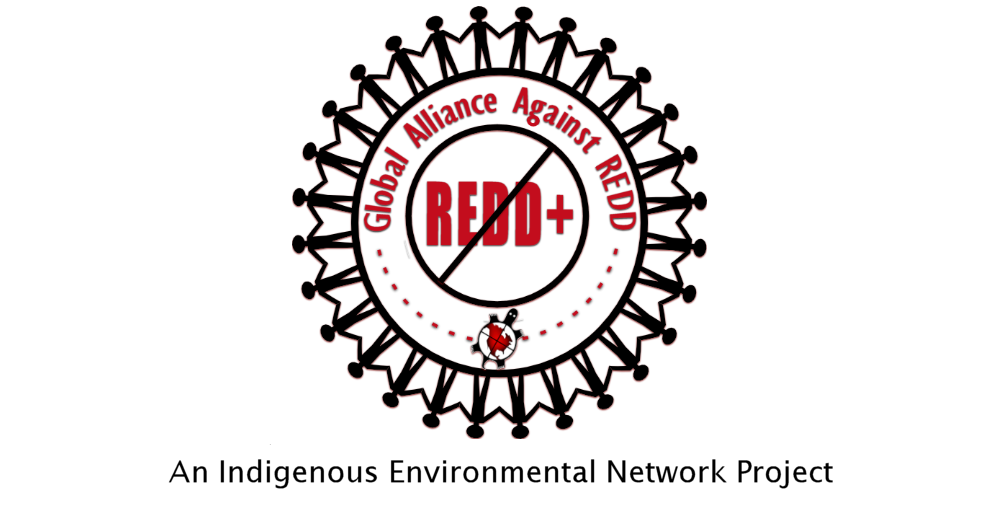Prologue: Former Kenya Forest Service director Emilio Mugo was recently suspended and replaced over the ongoing destruction of forests all over the country. Environment CS Keriako Tobiko initiated a major shake-up in the corruption-riddled forest service.
Chris Lang in Kenya | 1 June 2018
 Since January 2014, Kenya Forest Service guards have carried out a series of violent evictions of the Sengwer indigenous people from their homes in Embobut forest. While the evictions took place the Kenya Forest Service was funded by international donors, including the World Bank, the European Union, and the Finnish government.
Since January 2014, Kenya Forest Service guards have carried out a series of violent evictions of the Sengwer indigenous people from their homes in Embobut forest. While the evictions took place the Kenya Forest Service was funded by international donors, including the World Bank, the European Union, and the Finnish government.
These internationally funded aid projects failed to learn the lessons from the previous projects. The evictions and violence against the Sengwer, and other indigenous peoples in Kenya, were simply ignored in project documents.
Now the UNDP and the Japan International Co-operation Agency (JICA) are working on developing a REDD programme in Kenya. A Draft Project Document produced in February 2018 shows no sign that any lessons have been learned.
Families torn apart
Ismail Kirop, a Sengwer man, describes what happened to him on 2 April 2017 when he was filming Kenya Forest Service guards burning houses in Embobut forest:
“I was spotted by KFS guards who started chasing me and shooting at me. I started running down a hill to evade the bullets whereby I tripped, injuring my knee and I fell down. The shooting stopped but a KFS officer got to where I was lying. He hit me very hard with the butt of a rifle, fracturing my upper right arm. The officer grabbed the bag that contained my two cameras, a laptop, iPad and other personal documents and disappeared into the forest.”
The quotation comes from a new report by Amnesty International that documents the ongoing impact of a series of violent evictions that have taken place since January 2014.
The report, titled, “Families torn apart: Forced eviction of indigenous people in Embobut Forest”, can be downloaded on Amnesty International’s website.
Amnesty International’s researchers interviewed more than 100 Sengwer people, some still living in Embobut forest, others who have been forcibly evicted. They also spoke to 50 decision-makers at local and national government level, and civil society activists and academics.
Embobut forest covers an area of about 22,000 hectares. It is the Sengwer Indigenous People’s ancestral home. In 2009, the government decided that in order to address deforestation, everyone living in the forest had to be resettled.
The Sengwer state that they have lived many generations in the forest and have protected it. The deforestation was a result of other communities arriving in the area. But the government did not differentiate between indigenous and newly arrived communities.
No free, prior and informed consent
In 2009, the government set up the Embobut Forest Task Force, consisting of politicians, forestry officials, community and civil society representatives. The decision to evict everyone living in Embobut forest was taken before the Task Force was created. The purpose of the Task Force was to determine how to implement that decision.
In March 2013, Sengwer representatives filed a petition at the High Court of Eldoret to challenge the eviction. The Sengwer state that during a consultation meeting, local government officials had threatened that if the Sengwer did not comply with the decision, they would face “unnamed dire consequences”.
Amnesty International notes that,
This constitutes a violation of the rights of Indigenous Peoples, whose free, prior and informed consent must be obtained if they are to be relocated from their ancestral land.
When the Task Force failed to find suitable parcels of land to move the forest residents to, instead of land, the central government imposed an offer of cash compensation to registered individuals of 400,000 Kenyan Shillings (about US$4,585).
Three Task Force members told Amnesty International that the Task Force opposed this decision. “It was wrong to go from 10 acres to 400,000 Shillings, they are not equivalent,” one member of the Task Force said.
January 2014: Violent evictions
In January and February 2014, Kenya Forest Service guards and police carried out mass forced evictions from Embobut forest. Somewhere between 800 and 1,500 homes were burned down.
Many people who were evicted received no compensation. One Sengwer woman who was evicted from Embobut forest is now living in a one room hut with three children and her mother. Her husband died six months ago. She told Amnesty International,
“This is the sixth place I have lived in since I moved out of the forest. My children face many problems with homework, you can see the capacity of the house is very small. I didn’t get compensation. If I had, I would have bought land… I lacked the money to afford transport to follow up and ensure my name was there [when forest residents were being registered for resettlement or compensation]. I did not complain. If did that, I would have had to spend a small amount of money, I had nothing.”
Evictions have continued. Sengwer representatives have reported more than 1,000 house burnings by the Kenya Forest Service since February 2014. Between December 2017 and April 2018 the Kenya Forest Service burned 341 homes.
On 16 January 2018, Kenya Forest Service guards shot and killed Robert Kirotich Kibor. They also seriously injured David Kosgei Kiptilkesi.
The responsibilities of external donors
Amnesty International’s report includes a section on the responsibilities of external donors, including the World Bank, the European Union, and the Government of Finland:
- From 2007 to 2013, the World Bank Natural Resource Management Project in Kenya. In 2013, Sengwer representatives submitted a complaint to the World Bank’s Inspection Panel, arguing that evictions had continued under the project. The Inspection Panel found that while the project did not directly support the evictions, the World Bank had failed to uphold the rights of the Sengwer indigenous people.
- In September 2016, the European Union launched its Water Tower Protection and Climate Change Mitigation and Adaptation (WaTER) project. Project documents show no signs of any lessons learned from the World Bank’s Natural Resource Management Project. The EU funding for the WaTER project includes €4 million for the Kenya Forest Service.
On 17 January 2018, one day after Robert Kirotich Kibor was killed, the EU announced the suspension of funding for the WaTER project. The EU is currently redesigning the project with the Kenyan government. - From 2009 to 2016 the Government of Finland funded a programme titled the “Support to Forest Sector Reform in Kenya”. The final report of the programme, written by the Kenya Forest Service and Finland’s Ministry of Foreign Affairs, makes no mention of the violent evictions of the Sengwer.
Finland is planning a new €9.5 million project titled, “Private Forestry and Forest Enterprise Support in Kenya”. The project would be carried out by the Kenya Forest Service. In January 2018, Sengwer representatives, and Human rights and environmental organisations, wrote to the Finnish government asking it to suspend funding. - As a result of these letters, and public pressure in Finland on the government, Embobut forest has now been removed from the geographic scope of the project, and the project start date has been delayed.
REDD and risks of continued violence
The UN Development Programme is another international donor featured in Amnesty International’s report. Since January 2017, UNDP and the Japan International Co-operation Agency (JICA) have been working on initiating Kenya’s REDD programme.
In February 2018, UNDP produced a 108-page Draft Project Document.
Siddharth Chatterjee, UNDP’s Resident Representative in Kenya, told Amnesty International that the Sengwer and other indigenous communities have been involved in designing the document. And UNDP’s Draft Project Document states that,
Measures have already been taken to ensure that forest communities people have been widely consulted during project preparations. These communities have representatives that are members of the interim task force for the development of the project document. This model was lauded by stakeholders as exemplary as time and resources were spent to engage in a serious and concerted manner before the project begun. Several contentious issues were discussed and it was agreed that the REDD+ readiness project would be an opportunity for dialogue and discussion of the way forward.
But David Kiptum Yator, Chairperson at the Sengwer Indigenous Peoples Coordinating Committee, told Amnesty International that,
“We requested them to organize for consultative meetings at community level in order to have support or rejection, but they insisted there are no funds… it is the Sengwer position that there’ll be no need of REDD+ if KFS are not ready to stop evictions and commit themselves to a constructive dialogue process that will lead to Sengwer securing their rights to live in and own their ancestral lands, working together with KFS and other state agencies and stakeholders to promote conservation.”
The Draft Project Document acknowledges “conflicts” between forest communities and the Kenya Forest Service:
[S]ome forests have been faced with competing conservation needs on one hand and livelihoods and historical land rights claims on the other. This has led to continued conflicts between the Kenya Forest Service and communities living in these forests.
But there is no mention in the Draft Project Document of the violence that the Sengwer have faced at the hands of the Kenya Forest Service guards. The document mentions the Sengwer only once. And that’s in a footnote, confirming that under the 2010 Kenyan Constitution, the Sengwer are recognised as Indigenous People.
An “Offline risk log” dated 22 November 2016 is included in the Draft Project Document. This acknowledges that REDD presents risks for Indigenous Peoples:
Indigenous Peoples are present in the project area; referred to as marginalized and vulnerable populations. There is potential that the project may affect their human rights, traditional ways of living and access to lands and natural resources.
But a “Social and Environmental Risk Screening Check-list”, also included in the Draft Project Document, includes the following question:
Would the proposed Project potentially affect the human rights, lands, natural resources, territories, and traditional livelihoods of indigenous peoples?
To which UNDP answers “No”. A note on the check-list explains that, if the answer to this question is “yes”, “the potential risk impacts are considered potentially severe and/or critical and the Project would be categorized as either Moderate or High Risk”.
The Draft Project Document states that, “No displacement and resettlement will be implemented as part of the project.” But as Amnesty International points out, the draft project document “does not clarify what approach will be taken under the project if the government continues to disregard their land rights”.
See also the Sengwer sections at www.ogiek.org
